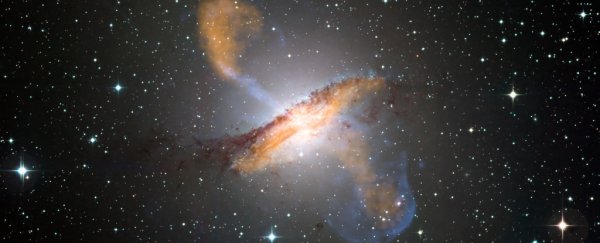Black hole scientists sure have been busy. At the end of last year, researchers announced that the powerful winds emanating from supermassive black holes shape entire galaxies.
Now, a new research paper has found the first observational evidence that supermassive black holes actually control the mysterious process of star formation in their galaxies.
At the centre of almost every galaxy is a supermassive black hole over a million times more massive than the Sun, but we don't really know much about them. We also don't fully understand why young galaxies are filled with rapidly forming stars, and what eventually causes this process to stop as the galaxy evolves.
Scientists have suspected for decades that the energy pouring out of supermassive black holes somehow "quenches" this process, but now researchers from the University of California, Santa Cruz have found the first direct evidence that this is actually what's happening.
The team have also shown that the mass of the black hole in question determines how soon star formation in a galaxy turns off. In other words, supermassive black holes aren't just shaping galaxies, they're controlling how many stars they have.
"This is the first direct observational evidence where we can see the effect of the black hole on the star formation history of the galaxy," said Jean Brodie, professor of astronomy and astrophysics at UC Santa Cruz and a coauthor of the paper.
The team figured this out by studying galaxies where the masses of the central black holes had already been measured in previous studies, based on the activity of the objects around them in space.
The team then analysed the spectra of these galaxies - how much light is coming from them - to determine their stellar history, whether they were still active, and how long they had been quiescent.
When they compared when the galaxies had stopped forming stars with the mass of their black holes they found striking differences.
These differences could not be explained by any other properties of the galaxy - size, shape, or internal kinematics.
"For galaxies with the same mass of stars but different black hole mass in the centre, those galaxies with bigger black holes were quenched earlier and faster than those with smaller black holes," Martín-Navarro said.
"So star formation lasted longer in those galaxies with smaller central black holes."
That means the mass of a black hole directly impacts how quickly star formation stops happening in a galaxy. But there's still work to be done. The mechanism that links the mass of the black hole to galactic quiescence is still unknown.
One idea is that it has to do with the 'active galactic nucleus' that can form around a black hole. Active galactic nuclei are discs of debris around a black hole that emit incredible amounts of energy as the black hole consumes matter. The most powerful of these are quasars.
A paper released in December revealed that, consistent with models of galactic evolution, quasar winds - feedback from the active galactic nucleus - blow into and shape the molecular gas from which stars are formed.
It's thought that this wind eventually "switches off" or quenches star formation by dispelling the gas.
But this is just one hypothesis.
"There are different ways a black hole can put energy out into the galaxy, and theorists have all kinds of ideas about how quenching happens, but there's more work to be done to fit these new observations into the models," said co-author of the new study Aaron Romanowsky.
The team's research has been published in the journal Nature.
